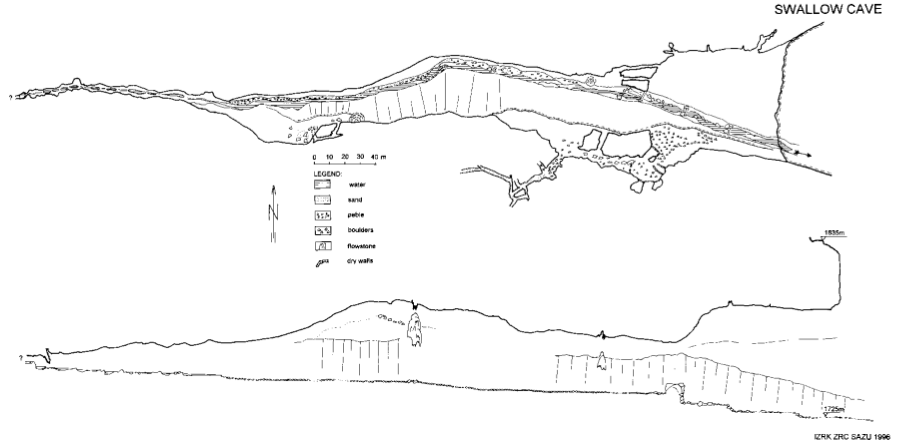
Grottes et karsts de Chine
Sur les traces de Xu Xiake
 Yanzidong - 燕子洞
Yanzidong - 燕子洞
Détail
Autres noms : Swallow Cave
Province, Préfecture, District :
Guizhou 贵州省, Liupanshui Shi 六盘水市, Shuicheng 水城
Latitude Nord - Longitude Est :
26.888560 - 105.009251
Altitude (m) : 0
Développement (m) : 938
Profondeur (m) :
Profondeur - / + (m) : 0 /
Volume (m3) :
Géologie : Trias inférieur
Carte
Description 1
1. Swallow cave: South of the bridge bellow the 90 m high wall there is an opening to the 50 m high and 70 m wide entrance into Swallow cave. In this part of the cave here are the remains of human dwelling and traces of saltpetre production from the cave sediments.
Cave was researched and surveyed upstream for about 500 m, total length of the surveyed part of the cave is 938 m. In the cave two morphological and genetic units can be seen an active narrow, high gallery and a maze of older, phreatic channels.
Active narrow and high gallery which rise in surveyed part for 21 m. Trough this gallery flows river which carries drift wood, among which 40 cm thick and several m long trunks were found, showing, that this river is a sinking river. The discharge of the river was about 50 l/s. Survey was done upstream until a lake and 3 m high cascade. The canyon is few m wide and about 20 m high, becoming lower upwards.
The main channel is developed along strong structural zone with faults and fissures in E-W direction and in some parts in fissures which form the angle of 450 with it, this is NE-SW direction. The wall rocks consist of thin bedded to platy dark grey in some places obviously bioturbated limestone and marly limestone with dissolution seems and stylolites. Smaller and up to ten cm large scallops are the most prominent features of the cave rocky relief.
Other morphologic unit of the cave is a maze of older, phreatic channels which are about 15 m above the actual stream in the entrance part. The galleries are dipping with strata and they used one bedding- plane for formation. The orientation of these channels is related to two different structural zones, the most important is E-W direction and the second one is NE-SW di- rection. At the entrance part of the cave smaller anastomoses channels are visible along three several metres separated bed- ding plan partings.
Sediments, gravel, sand and silt were found in upper parts of the cave, indicating older infill of the cave. From the small phreatic channel at the top of high gallery sample of sand mixed by silt was taken. It was analysed by x-ray on the Institute of Mineralogy, University of Ljubljana by the Phillips diffractiometre with CuKa (l = 1,54 x 101- nm) and automatic divergence slit. The analyse was shown the following min- eral composition: quartz, feldspar, chlorite, dolomite, muscovite, calcite, augite and saltpetre (KNO3). Quartz, chlorite, muscovite, feldspar and augite were brought into the cave by the stream from noncarbonate rocks. Dolomite and calcite are originated from cave walls.
Chen Xiaoping, Franci Gabrovsek, Huang Chuxing, Jin Yuzhang, Martin Knez, Janja Kogovsek, Liu Hong, Metka Petric, Andrej Mihevc, Bojan Otonièar, Shi Mengxiong, Tadej Slabe, Stanka Sebela, Wu Wenqing, Zhang Shouyue, Nadja Zupan Hajna- South China Karst I 1 Karst Studies of Yunnan 2 Cave Studies in W Guizhou (1998)
247p- Published by : Znanstvenoraziskovalni center Slovenske akademije znanosti in umetnosti, 247p., 1998
Analyse :
Members of the Karst Research Institute ZRC SAZU, Postojna, and members of the Yunnan Institute of Geography and Institute of Geology of the Chinese Academy of Sciences gathered the results of karstological researches of south Chinese karst in two projects adopted by an agreement on scientific and technological cooperation between the Government of the Republic of Slovenia and the Republic of China. The projects Karst Environmental Protection and Exploitation of Cave Resources and Study of Stone Forest Genesis, Function and Structures of the Underground Karst Aquifers in Lunan, Yunnan Province were going on from 1995 to 1997. They were made feasible by the Slovene and Chinese Ministry of Science and Technology and supported by Yunnan Provincial Science and Technology Commission, Administration of Stone Forest, and The Ninth Township Scenic Spots and Historical Sites Administrative Bureau, Yiliang County. The researches were carried out near Liupanshui, the western part of Guizhou, in karst between the mountains in Guizhou and Yunnan Plateau, in the area of Lunan stone forests and in cone-karst at Xichou, Yunnan.
2590 caractères - Lu 112 Fois
Bibliographie 2
GABROVSEK, Franci; JIN, Yuzhang; MIHEVC, Andrej; OTONICAR, Bojan; SHI, Mengxiong; ZHANG, Shouyue; ZUPAN HAJNA, Nadja(1998): Speleological Exploration at Tianshengqiao - Natural Bridge, Shui Cheng, NW Guizhou, S China. -
Proceedings of the 12th International Congress of Speleology. 1998, Switzerland, Volume 6: 32-35 (map & fig.) (engl. Summ.).
The geomorphological mapping of about 2 sqkm big area, exploration of three caves and their mapping, some measurement of main structural elements on the surface and in the caves, litology analyses, x-ray of sand and chemistry of the water from Swallow cave were done. The surface is well karstified, but shows surface fluvial forms, among which the deepest is the canyon of the Gan He river, which flows under the natural bridge. We visited seven caves but because of the lack of time and equipment we were able to survey only three of them. Cave system, and collapse depressions between them are strongly related to main faults and fissures directions. (auhtors; RB).
Source : BBS
Chen Xiaoping, Franci Gabrovsek, Huang Chuxing, Jin Yuzhang, Martin Knez, Janja Kogovsek, Liu Hong, Metka Petric, Andrej Mihevc, Bojan Otonièar, Shi Mengxiong, Tadej Slabe, Stanka Sebela, Wu Wenqing, Zhang Shouyue, Nadja Zupan Hajna- South China Karst I 1 Karst Studies of Yunnan 2 Cave Studies in W Guizhou (1998)
247p- Published by : Znanstvenoraziskovalni center Slovenske akademije znanosti in umetnosti, 247p., 1998
Members of the Karst Research Institute ZRC SAZU, Postojna, and members of the Yunnan Institute of Geography and Institute of Geology of the Chinese Academy of Sciences gathered the results of karstological researches of south Chinese karst in two projects adopted by an agreement on scientific and technological cooperation between the Government of the Republic of Slovenia and the Republic of China. The projects Karst Environmental Protection and Exploitation of Cave Resources and Study of Stone Forest Genesis, Function and Structures of the Underground Karst Aquifers in Lunan, Yunnan Province were going on from 1995 to 1997. They were made feasible by the Slovene and Chinese Ministry of Science and Technology and supported by Yunnan Provincial Science and Technology Commission, Administration of Stone Forest, and The Ninth Township Scenic Spots and Historical Sites Administrative Bureau, Yiliang County. The researches were carried out near Liupanshui, the western part of Guizhou, in karst between the mountains in Guizhou and Yunnan Plateau, in the area of Lunan stone forests and in cone-karst at Xichou, Yunnan.
Source :
Images 0
Topographie 1

Source : IZRK ZRC SAZU
Expédition 1
Recherche